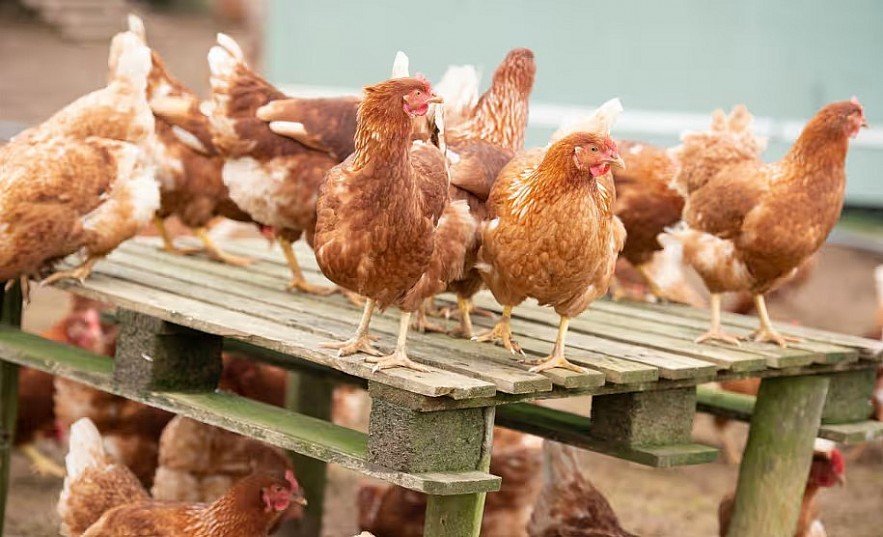Could Human H5 Bird Flu Spread to the U.S After Its Detection in Canada?
The recent detection of a presumptive human case of H5 bird flu in Canada has sparked concerns about the potential spread of this virus to the United States. While human infections with avian influenza are rare, the discovery of the virus in a Canadian patient has brought the issue of H5 bird flu back into the spotlight.
As public health officials monitor the situation closely, many are asking: Could H5 bird flu spread to the U.S.? And if so, how dangerous could it be, and what can individuals do to protect themselves?
 |
| Canada has confirmed its first presumptive human case of H5 bird flu in a teenager |
What Is H5 Bird Flu and How Dangerous Is It?
H5 bird flu, or avian influenza H5N1, is a highly contagious viral disease that primarily affects birds. It can, however, spread to other animals, including humans, though this is much rarer. H5N1 has been around since the late 1990s and has caused several outbreaks in birds worldwide. The virus is primarily spread through direct contact with infected birds or their droppings, but it can also spread through contaminated environments and materials.
For humans, the virus presents a serious threat. While H5N1 infections in humans are rare, they are often severe, with a high fatality rate. According to the World Health Organization (WHO), about 60% of known human cases of H5N1 have resulted in death, making it one of the most dangerous strains of avian influenza for humans.
The virus typically enters the human body through the respiratory tract, causing symptoms similar to those of a severe flu: fever, cough, sore throat, muscle aches, and difficulty breathing. In severe cases, it can lead to pneumonia, multi-organ failure, and even death. The transmission from human to human has been limited so far, but the risk of mutation remains a constant concern. If the virus were to evolve in a way that facilitated human-to-human transmission, it could trigger a global pandemic.
Canada's First Presumptive Human Case of H5 Bird Flu
Canada has confirmed its first presumptive human case of H5 bird flu in a teenager from the western province of British Columbia, as reported by health officials on Saturday, November 2024. The teenager, who had direct exposure to infected birds, is currently being monitored in stable condition, and authorities have implemented immediate measures to trace anyone who may have been in close contact with the individual.
This case marks a significant development in the ongoing battle against avian influenza, as it is the first time a presumptive human case has been reported in Canada during this particular wave of bird flu outbreaks. Health authorities have emphasized that the risk to the general public remains low, but they are keeping a close watch on the situation. The Canadian case follows a broader pattern of increased H5N1 infections among wild birds and poultry in North America, which has sparked growing concerns about the potential for further human cases and the possibility of the virus mutating to allow human-to-human transmission.
Local health officials have advised anyone who has had direct contact with infected birds to seek medical attention if they develop symptoms similar to flu. Given the severity of H5N1, which has a high fatality rate in humans, the detection of the virus in a person is a reminder of the potential dangers of the virus and the need for continued vigilance.
Could H5 Bird Flu Spread to the U.S.?
With the recent detection of a presumptive human case of H5 bird flu in Canada, concerns about the virus spreading to the U.S. have intensified. The case in British Columbia is the first confirmed human infection in Canada during this wave of avian flu outbreaks, following a significant rise in H5N1 cases among wild birds and poultry across North America. While the risk of widespread transmission remains low for the general public, the situation is being closely monitored due to the virus’s potential to mutate and adapt.
H5N1 and Migratory Birds: A Growing Concern
One of the primary factors contributing to the spread of H5N1 across North America is the migratory patterns of wild birds. These birds, which travel vast distances across the continent, can carry the virus from one region to another, potentially introducing it to new areas, including the U.S. Over the past year, multiple states in the U.S. have reported outbreaks of avian influenza in both wild birds and poultry. As the seasons change and migratory birds move south for the winter, the risk of further spread increases.
U.S. Readiness and Precautions
The U.S. has been on high alert, with both the Centers for Disease Control and Prevention (CDC) and the U.S. Department of Agriculture (USDA) actively monitoring the situation. While human infections in the U.S. remain rare, the detection of H5N1 in Canada has prompted heightened surveillance and response strategies along the U.S.-Canada border. Authorities are emphasizing the importance of quickly identifying and isolating infected animals and taking preventive measures to protect at-risk groups, such as poultry workers and veterinarians.
Human-to-Human Transmission: A Key Factor
The primary concern is the possibility of the virus mutating to allow easier transmission between humans. While human-to-human transmission of H5N1 has been limited to date, the risk of genetic mutations remains. If the virus were to evolve in such a way that it could spread more easily among humans, it could pose a significant threat to public health. This is a scenario that health officials are watching carefully, although they stress that the virus has not yet shown signs of widespread human-to-human transmission.
Current Risk in the U.S.
As of now, the risk of a large-scale H5 bird flu outbreak in the U.S. remains low for the general population. Health experts continue to stress that the most likely route of infection for humans remains through direct contact with infected birds or contaminated environments. However, as seen in Canada, even a limited number of human cases can raise alarms and prompt increased precautionary measures. The U.S. government is already working closely with Canadian officials and other international health agencies to track and contain any potential cases.
What Should Americans Do?
For most people, the best course of action is to stay informed and follow public health guidance. If you work in close contact with poultry, or live in areas with known outbreaks, it is important to take necessary precautions such as wearing protective gear, avoiding direct contact with sick birds, and following proper hygiene practices. As the situation develops, U.S. health officials will continue to update the public on any new risks or changes in transmission patterns.
How to Protect Yourself from H5 Bird Flu
Although the risk of contracting H5N1 remains low for the general public, there are several precautions that individuals can take to reduce their risk, particularly for those in close contact with birds or poultry.
Avoid Contact with Sick Birds: If you live in an area where bird flu has been reported, avoid contact with wild birds or poultry. Do not handle sick or dead birds, and if you must, wear gloves and protective clothing. Wash your hands thoroughly afterward.
Follow Health Advisories: Stay informed about any local outbreaks of bird flu, especially if you work with or around birds. Public health agencies, such as the CDC, provide guidance on how to handle any potential risks.
Practice Good Hygiene: Frequent hand washing with soap and water is one of the simplest and most effective ways to reduce your risk of infection. If soap and water are unavailable, use an alcohol-based hand sanitizer.
Cook Poultry Thoroughly: H5N1 is typically spread through direct contact with infected birds, but it’s important to ensure that any poultry you eat is thoroughly cooked. Cooking meat to a temperature of 165°F (74°C) kills the virus.
Monitor for Symptoms: If you have had direct contact with infected birds and develop flu-like symptoms, seek medical attention immediately. Early detection can help manage the illness and prevent it from becoming more severe.
Vaccination (For At-Risk Groups): While there is no specific vaccine for H5N1 yet, research is underway, and there are vaccines that may offer partial protection. In some cases, antiviral drugs like oseltamivir (Tamiflu) may be recommended for those who have been exposed to the virus.
Conclusion
The detection of a presumptive human case of H5N1 bird flu in Canada has raised concerns about the potential for the virus to spread to the U.S. While human infections remain rare and human-to-human transmission is not yet a significant threat, vigilance is essential. Public health authorities are closely monitoring the situation and taking preventive measures to contain any outbreaks. For most people, the risk remains low, but individuals in affected areas should follow recommended precautions to protect themselves.
FAQs
1. What is H5N1 bird flu?
H5N1 is a strain of avian influenza (bird flu) that primarily affects birds but can occasionally infect humans. It has a high fatality rate in humans, though cases are rare.
2. How does H5N1 spread to humans?
Humans can contract H5N1 through direct contact with infected birds, their droppings, or contaminated environments. In rare cases, it can spread to humans from birds.
3. Is H5N1 contagious between humans?
Currently, human-to-human transmission of H5N1 is very rare. The virus mainly spreads from bird to human, but there are concerns if it mutates to allow easier transmission between humans.
4. What are the symptoms of H5N1 in humans?
Symptoms include fever, cough, sore throat, muscle aches, and difficulty breathing. In severe cases, it can cause pneumonia and organ failure.
5. How can I protect myself from H5N1?
Avoid contact with sick or dead birds, practice good hygiene (frequent handwashing), and cook poultry thoroughly. If you're in an area with bird flu outbreaks, follow local health advisories.
6. Should I be worried about an outbreak in the U.S.?
While the risk remains low, the U.S. is monitoring the situation closely. Authorities are taking steps to contain any potential outbreaks. Stay informed and follow recommended safety guidelines.
 Facts about H5N8: First case of avian flu transmitted from birds to humans Facts about H5N8: First case of avian flu transmitted from birds to humans |


























